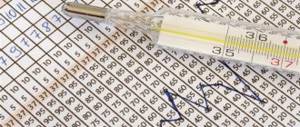Are you planning a pregnancy and want to calculate the most favorable days for conception? Then you just need to determine your ovulation, which will tell you with all its appearance that it’s time to act. There are more than enough ways to determine ovulation. As a rule, for this, most women use one of the most common methods - ovulation tests. This is a good opportunity to quickly find out the desired result. However, tests also have their own tricks and subtleties in conducting. Therefore, in our article we will talk in detail about everything every woman needs to know about ovulation tests.
So, how can the test help you find out when ovulation has occurred? Women should know that the menstrual cycle consists of 2 phases: follicular and luteinizing. In the first phase, the follicle matures in the female body, and the more it matures, the higher the level of estrogen (the main female sex hormones) it produces. When the amount of estrogen reaches the level required for ovulation, a large release of luteinizing hormone (LH) occurs. This means that ovulation will occur in the next 24-48 hours. The test, in turn, determines precisely the increase in LH levels.
On what days should tests be carried out?
Testing days are determined depending on the length of the menstrual cycle. If a woman has a regular cycle (that is, it has the same duration), then calculating the days will not be difficult, but if the cycle is constantly confused, then the calculations will require some effort. There is a rule with the help of which these very days are calculated, and its name is the “minus 17” rule.
Testing days are calculated according to this rule as follows: you must always subtract 17 from the total duration of the menstrual cycle. For example, if your cycle has a duration of 28 days, then you must subtract 17 from 28 - and you will get the number 11. And this means that exactly From the 11th day of your cycle, you can start doing ovulation tests. With a cycle length of 35 days, the optimal day to start testing would be the 18th day of the menstrual cycle. If the cycle is not regular, then you need to take the shortest duration of the menstrual cycle over the last six months as the basis for the length of the cycle, and subtract 17 from it.
How to determine ovulation
A woman can only become pregnant during ovulation. It lasts on average 24 hours. During this period, the chance of getting pregnant increases to 33%. Favorable days for conception are also considered two days before ovulation and two days after it.
Sperm are more viable than a woman’s reproductive cell (its lifespan is one day). Their activity in the cervix lasts 3-4 days, and sometimes up to 8 days.
This is why you should not 100% trust the well-known calendar of safe days. After all, even if you do not have unprotected sex during ovulation, and the last time you had sexual intercourse occurred 5 days ago, there is a possibility of pregnancy.
All pharmacies sell ovulation tests. They determine the period when the chances of success are greatest.
Types of lutropin capacity testing systems:
- stripes;
- cartridges;
- jet systems;
- optical instruments for determining the capacity of luteotropin in saliva.
A surge in luteinizing hormone (LH) is characteristic of ovulation. Therefore, if the procedure was done correctly and you have two scarlet lines, the level of luteotropin has reached its peak, which means the result is positive.
Features of the event
Do you think that you can conduct a test during the day when you have free time or a convenient moment? Then you are wrong. Because for the correct result you need to strictly adhere to all the basic rules of conducting an ovulation test.
Features of LH testing:
- The test must be performed twice a day. This is necessary in order not to miss the moment of a sharp release of luteinizing hormone. After all, after the release of the hormone, in less than 24 hours, its level decreases significantly. Therefore, if you test once a day, you may simply miss your chance of successful conception.
- Testing can be done at any time of the day, but it is important that it is the same time every day. The most suitable time to perform an ovulation test is the morning.
- Before testing, you should not drink too much liquid, and you must refrain from urinating for 4 hours before the test, otherwise the hormone level will decrease and the result will be negative.
It is also important to remember that the level of luteinizing hormone is affected by medications, as well as certain diseases, especially hormonal disorders. If you have hormonal problems or are taking any medications, it is possible that your test result will be incorrect.
"Insure"
Another test, produced in Russia. Regular test strips, reminiscent of the previous example. However, the accuracy this time is slightly higher due to greater sensitivity.
- Operating principle . Like all strip tests, it works by determining the level of the hormone LH. It is recommended to start testing on days 8-9 in order to determine the desired period as accurately as possible. The counting of days begins from the first day of menstruation.
- Instructions for use . Used in the same way as in the previous case. The test strip must be dipped into a container with urine. It is recommended to collect it in the morning or evening, and it is not recommended to drink a lot of liquid 4-5 hours in advance so that the concentration is most accurate.
- Decoding the results . There are two stripes on the test. One is the control one, always visible after the test. On its basis, the second one should be compared. If it is not visible or the color is poorly visible, then the desired period has not yet arrived. When the second stripe becomes as close in color as possible to the control one, we can assume that ovulation has begun.
- What is included . The kit contains 5 test strips. Each has its own packaging that protects from light and germs.
- Where to buy and price . Available in all well-known pharmacy chains. The average cost is 200 rubles.
Can ovulation tests be wrong?
This question perhaps interests women most of all. But there is a clear answer to this question. Tests, like people, can make mistakes too. No matter how reliable they are, for one reason or another, tests can “lie.” The bad thing is that a woman does not always realize this and, sometimes, it happens that a woman takes a false positive result for reality. But when pregnancy still does not occur, disappointment occurs. In order to avoid such situations, it is necessary to know under what circumstances the test result may be false.
It is important to remember that tests do not show ovulation itself, but only an increase in the level of luteinizing hormone, which precedes its onset. However, LH can increase not only due to approaching ovulation, but also for many other reasons. For example, if a woman has reached postmenopause (a period in a woman’s body characterized by the final cessation of menstruation) or has hormonal dysfunction, kidney failure, ovarian wasting syndrome, etc., then the tests may give a false positive result.
If a woman has already become pregnant, but does not yet know about it, then when conducting an ovulation test, the result will also be false positive. This is due to the fact that hCG, the so-called pregnancy hormone, is very similar in molecular structure to LH, so its level of increase in the body can give a false test result. Even if a woman is not pregnant, but she has been given an hCG injection, there is no point in testing. The result will be false positive.
Ovulation test data can be influenced by nutrition, as well as other hormones produced by the body. Therefore, if you have any disorders in the body, based on the list above, then there is no point in spending money on expensive tests, they will be falsely informative. In this case, if you really need to find out exactly the time of ovulation, then do better ultrasound diagnostics, she is the “queen” of medicine in this matter.
How does an ovulation test work (Everything about a positive test!)
The most popular ovulation test detects a surge in luteinizing hormone (LH) in the urine. 12-48 hours after the increase in LH, the egg is released and the woman becomes capable of conceiving. A positive ovulation test result is one where the test line is the same color as the control line or brighter.
Ovulation is the moment when a follicle in the ovary ruptures and an egg ready for fertilization is released. This process is triggered by a sharp jump in LH in a woman’s body, when the amount of the hormone in the blood becomes 21.9-56.6 mU/ml. It is this surge that the ovulation test tracks. In the next two days after the rise in LH, the follicle ruptures.
Luteinizing hormone first enters the blood and then the urine. If the urine contains a lot of LH (above the threshold value of the test strip), the ovulation test will give a positive result.
(!) In approximately 75% of women, the surge in luteinizing hormone begins from 12 am to 8 am. Moreover, if your test strip is positive today, this does not mean that ovulation has occurred. It will happen today, tomorrow or the day after tomorrow.
For most manufacturers, the threshold value, that is, the sensitivity of the ovulation test, can be 20-30 mIU/ml. The lower this number, the more clearly the test strip appears.
Attention(!) If the second line is not as bright as the control line or is absent altogether, this is a negative test result (here is the main difference between it and a pregnancy test). There will be no ovulation in the next 24 hours. Of course, subject to following simple testing rules.
Detailed instructions for performing an ovulation test
The start date of testing is usually determined as follows: the number of days of the cycle minus 17 (read more about this here). The procedure must be carried out every day at the same time (± 30 minutes) from 8 to 20 hours.
Tips for conducting the test correctly are as follows:
- Avoid urinating for 4 hours before the test. This is easier to do if you drink just a little liquid, no more than 0.5 glasses.
- Prepare a clean and dry container for urine (a small plastic cup for alcohol is most convenient), as well as a mobile phone or watch. If you use test systems or cassettes that can be placed directly under the stream, there is no need to prepare the container.
- Before testing , collect urine and unpack the box . It is better to carry out the test immediately, with fresh urine (this way the reagents will work better).
- Check the instructions for the number of seconds of immersion in urine (or substitution under the stream), the specifics of testing, as well as the length of time to wait for the result. If you have lost the instructions, go to this page, where I have collected information about the most popular ovulation tests with photos.
- Open the individual test strip packaging and immerse it in urine for the number of seconds recommended by the manufacturer (this can be 5-30 seconds) until the MAX mark . After this, place the test strip horizontally on a clean, dry surface for the required number of minutes (1-20 minutes according to the instructions).
- Evaluate the result. Take a photo of the test while the test area is still wet. After drying, the brightness and boldness of the stripes may change slightly. Usually the manufacturer states in the note: “Do not evaluate the result after XX number of minutes.”
- Continue testing daily (preferably 2 times a day) until a negative result appears after a positive test and you feel signs of ovulation (more on them below).
This is how the level of LH in the urine gradually increases. Accordingly, the test strip gradually brightens:
Gradual increase in test line saturation on an ovulation test
When a hormone surge occurs, the second strip becomes as saturated as the control (or even brighter).
Ovulation tests are first negative, then positive, then negative again after a decrease in LH
The day after ovulation the test becomes negative. After the release of UC, there is no longer a need for such an amount of LH in the body and its level drops.
Here is a photo where the ovulation test is first negative, then positive, and then negative again:
Ovulation test is first negative, then positive, and then negative again
How many days is the ovulation test positive?
Exactly as long as the increase in LH levels lasts. The luteinizing hormone surge graph can look completely different in different women. Because of this, the brightness pattern of the stripes on the test in the preovulatory period will be different.
In other words, ovulation tests may be positive for different numbers of days. In most cases, positive results are observed one or two days in one menstrual cycle (but no more than three days!).
Below I present several different types of LH graphs created based on research in the journal Fertility and Sterility and their corresponding test staining schemes:
The duration of the LH surge may vary. the maximum normal number of positive tests is three. Most often only 1-2 positives per cycle
All of the above options demonstrate the normal functioning of the reproductive system and pregnancy is quite possible.
When does ovulation occur after a positive test?
Many women ovulate within 12-36 hours of their last positive ovulation test.
For example, if two equally bright stripes were on the 16th and 17th DC, then ovulation will most likely occur from the 17th to the 19th day of the cycle.
Shortly before the release of UC, most women notice a change in the cervical fluid: it becomes more liquid, transparent and mucous, like the white of an egg.
During ovulation, many will feel pain in one of the ovaries or in the lower abdomen. Painful sensations in the lower back or rectum also occur - it all depends on the individual physiological characteristics of the woman and her pain threshold.
Unreasonable nausea can also accompany ovulation. You can learn more about all the signs and symptoms of ovulation in this article.
The ovulation test is positive, but then there is no ovulation - reasons
So, if ovulation tests consistently show an LH peak, and pregnancy does not occur within 6-12 months, it is recommended to do an ultrasound.
There are cases when the ovulation test gives a positive result, but the follicle does not burst and does not release the egg, although the basal temperature seems to rise and menstruation occurs at the expected period.
There are three explanations for this phenomenon:
- A premature LH surge occurred when the dominant follicle had not yet reached the required size of 18-23 mm. Most likely, a little later there will be a new surge in LH and then the follicle will burst and release mature UC. It is important to continue regular intimate life until you are sure that the second phase has begun (basal temperature will rise by 0.3-0.5 degrees compared to the first phase).
- Polycystic ovary syndrome , when there are surges in LH levels, after which the follicle does not rupture. Diagnosed by ultrasound.
- Luteinization of a non-ovulated follicle (LNF) . In this case, the hormone levels are normal, but the egg is not released. Although the corpus luteum is not formed, the luteinized dominant follicle produces progesterone instead. LNF can only be detected by ultrasound.
(!) According to statistics, from 6 to 25% of all cases of infertility are associated with the presence of LNF. There is evidence that long-term use of anti-inflammatory drugs can cause this problem. For example, when treating autoimmune diseases, endometriosis or arthritis, there is a risk of developing LNF.
When, nevertheless, ovulation occurs normally, but there is no pregnancy, I recommend reading a detailed article about other common reasons for unsuccessful planning.
If the ovulation test is always negative
Here are some explanations for why there are no positive ovulation test results:
- There was no ovulation yet . Incorrect testing is especially common in women with irregular cycles or oligomenorrhea (infrequent periods). A detailed testing scheme for an irregular cycle is described in this material.
- Anovulation (lack of ovulation). It can be physiological, for example, ovarian rest 2-3 cycles per year, in women 35+ the number of ovulatory cycles gradually decreases, breastfeeding, pregnancy, and pathological, for example, with PCOS, hyperandrogenism, thyroid dysfunction, etc.
- Poor test or testing violation . Oddly enough, this is also a common reason for difficulties in detecting ovulation using test strips. Try several different manufacturers (you can use inexpensive ones), make sure that the expiration dates are not violated. Do not use night or morning urine (it is recommended to “catch” LH after 10 am and before 8 pm). Do not drink a lot of water before testing, and it is also recommended that you do not urinate for 4 hours.
- False negative result , when in fact a jump has occurred, but due to the low concentration of LH in the urine, the test produces a pale second line. In paragraph 3, several reasons for the decrease in test sensitivity are already described: poor quality of the product and violation of testing technique. In addition, a false negative result can be caused by kidney problems or increased levels of the hormone prolactin (for example, during breastfeeding).
Causes of negative ovulation tests - detailed explanation
If for three cycles in a row you fail to catch ovulation using tests, I recommend contacting your gynecologist.
Positive ovulation test - when to start planning
As soon as you have received a positive result, you can begin active actions. Intimacy on the day of ovulation and one or two days before it has a greater chance of ending in pregnancy.
Attention(!) The recommended interval between PAs is 2-3 days. This is especially important if there are difficulties with the number and motility of sperm (visible on the spermogram).
For example, if you had intimacy on the day of a positive ovulation test, it is better for the next PA to be 1 day later, then another day, and so on until signs of ovulation appear: pain or fullness of the breasts, increased BBT, body temperature above 37, disappearance of protein-type discharge.
There is a separate article with examples and recommendations for more information about intimate life before and after ovulation.
A special digital ovulation test for conceiving a girl
It is known that sperm carrying the female X chromosome are slow, but more tenacious. Boy sperm are faster, but quickly become depleted and die. This is the second most reliable method of planning the gender of a child after direct manual selection of sperm by a specialist at a reproduction center.
If intimacy occurs more than 2 days before ovulation, there is a high probability that it will be a girl. What then to do with ovulation tests that show the approach of a period of high fertility only in the next day or two?
In this situation, the best test option is the one that “catches” a surge in two hormones at once: LH and estrogen. This electronic test system will show the approach of ovulation in 3-4 days, that is, at the most favorable time for conceiving a girl. It's called Clearblue Advanced Digital Ovulation Test .
For most women, estrogen levels begin to rise 3-4 days before ovulation. When this happens, the test shows a flashing smiley face. To plan a girl, you should plan intimacy around the days of the flashing smiley face.
As soon as the unblinking emoticon appears, you must stop openly having sex.
Note(!) Unfortunately, this test system is not yet sold in regular pharmacies. You can order such a test to Russia on Amazon or Walmart. These are large, trusted online stores with the ability to deliver goods to various countries around the world.
There is a separate article about various ways to calculate the ideal period for planning a girl.
What is the best ovulation test?
In general, cheap and expensive ovulation test strips are not much different. The price is determined by the brand, the width of the testing surface, as well as the presence of additional “buns”, such as containers for collecting urine.
Note(!) The most budget test strips are very narrow, but you can recognize a positive result.
The only point is to choose tests with a sensitivity of 20-25 mIU/ml, since in some women the peak LH can be only 22-25 and test strips with a sensitivity of 30 mIU/ml will never be bright enough. This is why so many women complain about the insufficient brightness of stripes, for example, Frautest.
If your financial capabilities allow, choose digital devices to determine ovulation, then you will not need to bother with analyzing the saturation of the bands.
In the case of long or irregular cycles, when many tests are needed, you can order large quantities of cheap test strips (50-100 pcs.) via the Internet (there is a separate section with my ordering recommendations).
In conclusion , I will add that what is important is not the brand and price of the ovulation test, but how correctly it was stored and used. You can catch the beginning of your fertile period using the simplest test.
I recommend starting pregnancy tests 10 days after a positive ovulation test or the day after the first early signs of pregnancy appear.
Remember that positive results for more than three days in one cycle or the absence of a positive result for more than three menstrual cycles in a row is a reason to consult a doctor.
Happy second pages to you and a speedy pregnancy!
Source: https://Ovuliaciya.ru/testy/test-na-ovulyaciyu-kak-rabotaet
Types of ovulation tests
Can't decide which ovulation test to choose? No wonder. After all, there are many tests and each of them has its own characteristics, and, importantly, a different price factor. Therefore, before you go to the pharmacy to buy a test, familiarize yourself with its main varieties.
Test - strips
This type of test is the most common. In addition, the test strip is similar in principle to a pregnancy test, and it looks exactly the same. To get the result, you need to lower the strip into the urine for 20-30 seconds and wait until the second strip appears. The appearance of a second stripe usually indicates approaching ovulation.
However, on such a joyful note, we have to sadly admit the fact that test strips, in most cases, show a false result. Therefore, you shouldn’t rely too much on them. Their undeniable advantage is their low price, and given the fact that testing will have to be carried out more than one day, and even twice a day, for many women this fact becomes a powerful argument when purchasing this type of test.
How many days is the ovulation test positive?
Considering that a mature egg, which moves along the fallopian tube and is ready for conception, lives for 12-48 hours, no more, an ovulation test can be positive for about two days. If the test shows two lines for quite a long time, you need to consult a doctor in order to find out the reasons that provoke an increase in the concentration of luteinizing hormone.
What are the best ovulation tests?
Typically, there are a large number of different ovulation tests on the market.
The most popular of them:
- ClearPlan;
- FrauTest;
- EviPlan;
- Solo;
- Vera Iha-LG-Factor;
- ClearBlue.
This is a list of the most popular brands of tests that are used among women, but you should also take into account that each body is individual and it is best to purchase several tests from different brands at once. For example, 40% of women note that the FrauTest ovulation test on the day of their immediate ovulation shows a negative result.
Can an ovulation test show pregnancy?
An ovulation test cannot show that pregnancy has occurred. Of course, in practice there are cases when the test indicated a positive result during pregnancy. As mentioned above, this is due to other, more serious reasons.
Girls, if you know for sure that you are pregnant and the ovulation test shows two lines, then you need to urgently go to the doctor; perhaps you have problems with women’s health that can harm both you and the baby.
How to correctly decipher test results
You can't always feel the approach of ovulation, but you can try to see it. If a surge of LH has occurred, the test should show two clear stripes, one of which will be the control line, the other will be the test line. If the test strip is significantly darker than the control strip, then the result can be considered positive.
Well, if the test one turns out to be lighter than the control one, or is completely absent, then, in all likelihood, the release of luteinizing hormone has not yet occurred. And the test must continue to be done. But if the test turns out to be positive, there is no point in further testing. Just use the next two days to successfully conceive a child. These days, called fertile days, are the most conducive for the forces of nature to give you the long-awaited baby.
Don't miss your chance when you see two lines on the test. Let their happy combination give you hope for the fulfillment of your main dream - the conception and birth of a little man.
Do you really want to become a mother? To greatly increase your chance of pregnancy, be able to determine the day on which you are most likely to conceive. You can really find out about this with the help of special testing. But sometimes women are interested in the question: can ovulation tests be wrong?
Unfortunately, the answer is yes. There is no means that guarantees an accurate picture. This is influenced by many factors, including the quality of the indicator itself, as well as the correctness of the measurements. In order to understand the situation, it is necessary to consider it in more detail.
Diagnostic results
Ovulation tests are impregnated with a reagent, which, when LH surges, is manifested by a color change. The onset of ovulation is checked by comparing the reaction with the control line:
- bright red color – the time of ovulation has come;
- a weak second line on the test means the ovulation phase has not occurred;
- slightly pale stripe – ovulation is expected in 1-2 days.
Test tablets reflect the result in a slightly different way. They have two windows, on one of them a sample of biological material is placed, and on the other the research result is displayed. Positive – a smiling emoticon is shown, negative – an empty circle.
In digital systems that examine saliva, the result must be carefully examined and compared with the interpretation of the drawings. It is included with the packaging of the ovulation device. Drawings can take the following form:
- The fern leaf, outlined by a uniform dotted line , is the appearance of saliva at the beginning of the cycle, when the follicle begins to develop.
- The middle of the fern leaf is filled with transverse lines - a weakly positive result. Indicates an increase in estrogen levels. The follicle reaches maturity.
- A fern leaf with clear contours - a mature egg has left the follicle and is sent to the uterus for fertilization.
Erroneous or false results
Testing systems are highly sensitive to changes in LH levels. Any surge in hormones can trigger the appearance of 2 stripes. Reasons for a false positive test:
- ovarian depletion;
- presence of kidney disease;
- postmenopause;
- protein deficiency;
- taking hormonal medications;
- taking contraceptives;
- pregnancy;
- stimulation of ovulation with hCG injections.
Sometimes during ovulation the test may give a negative result. The reasons are non-compliance with the testing instructions and the rules for preparing for analysis. After eliminating errors, the result will be reliable.
What is a rapid test?
The duration of the reproductive capacity of female cells is short. Therefore, it is important to know when the follicle will burst and the egg will be released in order to have an active sex life with your partner. According to gynecologists, if you want to conceive, have sex with your partner often.
Nowadays, girls often buy ovulation tests in pharmacies. They appeared quite recently, and come in different types, depending on the manufacturer. They have one purpose - to help the lady find out about the arrival of ovulation.
There are several types of testing systems that can be purchased at the pharmacy:
- With disposable lines;
- With disposable cartridges;
- Jet;
- Optical, detecting the hormone lutein using saliva;
- Electronic, with disposable strips;
If the result is negative, you are not ovulating yet.
But what if it's positive? This suggests that:
- Soon (within 1-2 hours) the egg will be released from the ovary. She will be ripe for fertilization;
- After exit from the gonad, the lifespan of the cell is 24 hours;
- Don't rush into having sex right away. Wait approximately 5 hours. Take a pause. But don’t forget about how long a woman’s cell lives. Don't be late.
- Don't put sex off until the deadline. Conception does not occur immediately after intercourse. This requires a couple of hours. At this time, the cells move one to another, and only then meet.
Does an ovulation test indicate pregnancy?
You can find reviews on the Internet that an ovulation test showed a woman’s pregnancy immediately after conception. During this time, conventional pregnancy tests gave false negative results. But you need to know that this is impossible. Once the egg has left the ovary, the test shows a negative result, even if conception has occurred.
Pregnancy tests show levels of a completely different hormone: hCG. Therefore, they do not respond to LH (which indicates ovulation). If you see two clear lines on an ovulation test, this means that the release of an egg from the ovaries is approaching, and not pregnancy.
Ovulation tests can be used as a form of contraception if you are not using other methods of birth control. This method is not relevant for everyone, because it needs to be tested constantly, and not just once. Therefore, you can spend a lot of money on tests. If the second line on your ovulation test is even slightly visible, you are better off using contraception unless you want to get pregnant right now. When the second stripe is completely invisible, it means that unprotected sexual intercourse can occur without the risk of conception.
How often can ovulation tests be done? If the economic situation allows, then you can do such tests even every day of the month. Such methods are mainly used by women with infertility or those making futile long-term attempts to conceive a child. But in general, it is recommended to be tested closer to the expected ovulation.
On what days should the result be assessed?
The correctness of the data obtained largely depends on when they were recorded. Since no two organisms are alike, there is no single day to draw the right conclusions. Everything is complicated by the fact that many girls have an individual schedule, and it is not stable.
If you are lucky and have a stable menstrual cycle, you can easily calculate the approximate measurement date. It occurs 17 days before the next menstruation.
You need to start after 11 days. Calculating the date is simple - subtract 17 days from the number of days in the cycle. If your periods are irregular, there is no need for the procedure, since there is a high probability of getting false readings.
The time of collection also affects the indicators. If you think that it is best to evaluate them in the morning, then you are mistaken. It is better not to conduct tests immediately after sleep. The ideal option is a period of 1000 -2000 hours. Ideally, to ensure that the release of lutein is not missed, the procedure is repeated twice. First in the first part of the day, then in the second. This is important because the hormone level lasts less than a day.
Remember, if it becomes necessary to repeat the procedure the next day, do it at the same time as yesterday.
How to do an ovulation test at home correctly
Recommendations for conducting independent research:
- refrain from drinking for 4 hours;
- 2 hours before the diagnosis, do not go to the toilet;
- collect the second portion of morning urine;
- Recommended time for testing is from 9.00 to 21.00;
- every 12 hours;
- limit the intake of hormonal drugs for 7 days;
- on hot days the diagnosis may be erroneous;
- Ovulation test strips are unpacked immediately before use.
Step-by-step instructions for the procedure
Testing rules depend on the type of diagnostic system. When using strips and digital instruments that examine urine, the order is as follows:
- collect the second portion of morning urine in a sterile container;
- carefully unpack the packaging;
- lower the test strip into a container with urine for 5-10 seconds to the indicated level or place it under the stream;
- take out the dough and place on a dry surface;
- the result appears in 3-10 minutes.
When using a digital electronic device for analysis of which saliva is taken, the following instructions should be followed:
- 2 hours before the test, refrain from eating and drinking;
- carry out the study before brushing your teeth;
- open the device and apply a drop of saliva to the glass slide;
- wait 5-10 minutes for the saliva to dry;
- The resulting drawing is examined on another slide and compared with the transcript.
Features of the event
Using tests to determine ovulation at home is very simple. They show an accurate picture if you followed the instructions that are included in the kit, and also calculated everything correctly for the cycle.
When to do the procedure is up to you. But remember that your bladder must be full to perform the test. To do this, avoid urinating for at least four hours. And don't fill the bubble artificially. If you drink a lot of fluids, LH will distort everything.
- Collect a medium portion of urine (50 milliliters) into a clean container.
- Lower the strip to the line for 5 seconds.
- Place it on a clean and dry surface.
- After 10-20 seconds, evaluate the result you obtained.
When does ovulation occur?
Ovulation does not always occur in the middle of the monthly cycle. That’s why ovulation tests are so relevant and more accurate than calculating using a calendar. Surely you know cases when a couple conceived a child by accident on those days that the woman considered safe.
Factors affecting egg release:
- climate change
- infectious diseases
- stress
- other changed environmental conditions requiring certain adaptation of the physical and mental body
If you use the above days to start the ovulation test and cannot “catch” it, try starting testing earlier.
Is there a possibility of error?
No device is perfect. And if you don’t know whether an ovulation test can lie, then the answer is: very rarely, depending on the processes occurring in the woman’s body. But how do you understand: the data you received is true or not? It is impossible to completely refute or confirm them, but if you do it two, or better yet, three times in a row and all the indicators are identical, it is most likely that what you see is the truth.
And although it is impossible to exclude a lie, you can reduce its likelihood. For this:
- Make purchases only at the pharmacy;
- Pay attention to the expiration date and storage conditions;
- Pay attention to information about the manufacturer. Companies with a well-known name will not risk their reputation and will not produce defective products;
- Use high-quality products, since with cheap indicators it is most difficult to achieve a true result. They are made from low-quality raw materials. It often happens that their absorbent part gets wet and shifts towards the coloring pigment, which indicates that the girl is pregnant;
- Use the device correctly. Thus, an error may result from incorrect residence time of the indicator in the urine. It may not have time to become saturated with biological fluid, which will lead to erroneous conclusions. If you overexpose it, or dive above the norm indicated on it, you can also get a distorted picture.
Reasons why ovulation is not detected
It happens that the process is done according to the instructions, but the strip is silent and does not show anything. You need to determine the day to conceive a child, but for some unknown reason nothing happens. Why?
Many ladies refer to the prevailing opinion that they were sold defective products. This also cannot be ruled out, but we must not forget - in this case, both the first and second stripes will not be visible. Very often, the reason for false indicators is that the test is used incorrectly.
Sometimes the absence of indicators in some cycles can be regarded as normal. After all, do not forget that the process of ovulation does not occur every month. The older you are, the more often anovulatory cycles will occur. This is explained by the fact that over time, the supply of germ cells in the ovaries becomes less and less, and therefore the likelihood of pregnancy decreases.
Taking certain medications also has an effect. There is no point in taking measurements when you are taking oral contraceptives. Their principle of action is based on suppressing ovulation. This is how couples manage to protect themselves from unwanted conception.
And the last, most common reason is that the time was chosen incorrectly. Due to individual body structure, the incorrect interval may be calculated. And it won’t even be a matter of correct application of the computational formula. If menstruation is irregular, it is quite difficult to avoid mistakes.
What can distort the result of an ovulation test?
A test that has expired or is damaged in packaging can go bad. A proper test cannot show a complete lack of reaction. Because a girl always has LH in her body (albeit in small doses) and the shade should change, albeit slightly.
There will always be a slight, faint line on the ovulation test, even if there is no ovulation
This, by the way, is one of the reasons for the distortion of the result. Since everyone's body is unique, normal levels of the hormone may vary. In one person, the normal LH level may be the same as the LH level when the follicle ruptures in another. Therefore, if during testing immediately and on the following days the stripes are bright, the woman has a high level of the hormone. This option for determining the “right” moment will not work for her; she simply will not be able to distinguish the change in shade.
If a woman’s color changes slightly at the time of ovulation, it means that even with a surge of the hormone, it does not reach the average level. There is nothing wrong with this; reproductive function is not affected. There will simply be difficulties in determining the day for conception. It is worth choosing another option to identify it. For example, you can always use the online ovulation calculator on our website.
An online ovulation calculator will help you determine the date of its onset
When considering the reasons for the distortion of the result shown by the ovulation test and the weak line, which means not only the absence of hormone release, but also the influence of other parameters, you need to know the main reasons:
- The woman is currently taking medications containing hormones. The reagent reaction will be irrelevant.
- Hormonal disorders in the body.
- Insufficient time allowed for shade to be examined.
- The test was improperly stored or defective.
Do not forget that the reason for the faint shade of the ovulation test strip can be trivial - the cell has matured and came out ahead of schedule.
The LH level rises only at the moment of follicle rupture and lasts only one day, after which the level drops to normal. Continuing to do tests after ovulation is completed, the woman will not see a change in color. Quite common reasons can cause the cell to mature earlier:
- constant stressful situations;
- going on vacation to a country with different climatic conditions;
- disease, infection in the body.
As you can see, understanding the test and the rules is quite accessible. It is also easy to understand the reasons for the appearance of a weak line on an ovulation test. But you need to strictly follow the instructions and choose the right first day for measurement. If there are doubts about the reliability, it is better to use additional means to detect ovulation, and also listen to the body’s signals (breast tenderness, mild pain in the area of one of the ovaries, “egg white” type discharge).
How to correctly decipher the results?
Everything is simple with the system. But how to decrypt the data that is received? There is nothing complicated about this either. If there is no first control strip, the device is considered unusable and defective. It will not show true information.
If the second stripe is missing, it means that ripening has not yet occurred and you need to wait. A result with two stripes is assessed as positive. The device shows lines that are equally bright and saturated, or the second one is superior to the first in these indicators. It is brighter the closer ovulation is. Expect the egg to be released in approximately 12 to 48 hours. Having sex on these days has a greater chance of successful fertilization.
There is a line on the test, but it is faint or pale - there is still too little LH in the body. Repeat everything the next day.
But know that this method does not guarantee you 100% success. He only talks about the maximum opportunity to achieve results. It is also impossible to guarantee that pregnancy will not occur if one line appears.
Basic rules for conducting an ovulation test
An ovulation test, a weak line on which may indicate incorrect performance, should be used according to the manufacturer's instructions. They may differ in such nuances as the waiting time, but the order usually corresponds to the algorithm:
- Collect urine in a container.
- Dip the test into the liquid to the special mark. Hold for a few seconds.
- Take out the test and set aside for 5 minutes.
- Check the result.
To avoid mistakes, you need to follow some rules. In particular, be systematic so that samples are collected at regular intervals. Having taken the measurement, for example, at 11 o’clock, the next day you need to do the analysis at the same time. If there is a danger of missing the moment, it is better to take 2 measurements per day. It is advisable that both times the time be between 10 am and 8 pm.
Why do ovulation tests show a faint line?
A weak line on an ovulation test may also appear if the LH concentration is decreased randomly or, on the contrary, may be slightly higher than normal, so you need to remember the generally accepted principles:
- Do not analyze the first urine after sleep;
- do not drink a lot of fluids a couple of hours before the test;
- do not visit the ladies' room at least 3 hours in advance.
When analyzing the result, you need to check the instructions. Usually in the pictures there is a tint indicating a high concentration of LH. What you can see on your strip test:
- The strip has slightly changed color: you need to test again tomorrow. If the second ovulation test also shows a weak second line, we continue further.
- The strip is no different from the control or brighter: ovulation has occurred. In the next 10-15 hours you should start conceiving.
- There is no line: the test is not working properly or the measurements were not taken correctly (failure to follow the instructions).
What to do if ovulation is not detected?
It is worth understanding that there is no reason to panic yet. If you cannot determine the moment of ovulation, this does not mean at all that you will never be able to become a mother. It happens that it is impossible to immediately determine ovulation. Then just wait a little.
After an examination, the gynecologist sometimes discovers that there is no egg ready for the process of conception, or that your case is non-standard. Then it will be necessary to undergo the recommended tests, and without fail, ultrasound folliculometry.
Changes in the body also indicate the arrival of the cherished day. If you read the reactions that occur correctly, it is not difficult to determine the moment.
- Various processes in the chest. Starting from barely noticeable tingling in the nipples and ending with swollen mammary glands.
- Sudden changes in mood from positive to negative.
- Unusual sensations in the stomach. Feeling of slight pain or stabbing and pulling pressure on the perineum.
- Large amount of mucous leucorrhoea.
- Suddenly the desire for sexual activity arises.
The occurrence of such symptoms is not at all necessary, but if you notice them, there is a high probability that the day has come to act. Therefore, it is advisable to urgently go to the pharmacy and buy the device.
Conclusion
Due to the increased demand for these products, which determine the moment of ovulation, manufacturers offer a huge selection of quality products. There are many brands that produce such devices: Evitest, Biola, Clearblue, Eviplan and others. They belong to different species and are defined in different ways, but their essence will be the same.
But some couples who want to have their own family ask: can an ovulation test be wrong?
The manufacturer claims that if all the nuances of the procedure are followed correctly, then the error is 1-2%. Agree that the chances of a lie are tiny.
When to take an ovulation test
To prevent the ovulation test from showing a weak second line, you need to correctly schedule the time for collecting samples and follow the rules (instructions). Most women know that ovulation occurs approximately in the middle of the menstrual cycle. The latter is counted as the number of days between menstruation (their first days). Ideally, it is in the range of 25-29 days, but deviations are possible - 21-35.
Ovulation occurs around the middle of the cycle
Ovulation stands at the border of two periods. In the first, the cell matures, and in the second, the corpus luteum forms in the place of the ovary that has suffered damage due to rupture. This very body produces a hormone that has a beneficial effect on the process of conception and development of the embryo. In the absence of this, the cycle usually ends with menstruation. The second stage is always 14 days - this is the time required for the healing of the ovary and “tuning” it to the new work of cell development. Failures are possible, but experts say that it does not last less than 11-12 days. But the first period is different for ladies.
Useful formulas
- Day of ovulation: subtract 14 from the duration of the cycle;
- Testing start day: subtract 17.
What are the criteria? Usually the duration of ovulation is 1-2 days, in rare exceptions – 3. In order not to miss the moment, the maximum indicator was selected. On the first calculated day, ovulation tests show a faint line; on the second or third day, the result may become obvious. Sometimes it will take 5 days before a reaction is detected.
Why doesn't the ovulation test show it?
There are situations when everything is done according to the instructions, but the test is “silent” and shows nothing. Women expecting a child cannot wait for this cherished period of possibility of conceiving a baby to arrive, and undergo additional tests. But this is not always justified, and it is also expensive. So why doesn't an ovulation test show ovulation?
Bad test
Such tests are not as common as pregnancy tests, so you have to buy what is available at the pharmacy. And this may not be a quality product. Tests differ in cost and characteristics, and their reliability also depends on this.
- A strip test is a paper strip with a reagent that reacts to changes in a woman’s hormonal levels, in particular to luteinizing hormone. Such tests do not always show clear bands. There are two reasons for this: poor quality and the egg is ready to be released, but it is still in the follicle.
- A test tablet is a plastic case with windows in which you can see the result. If, after a drop of urine in the first window, two stripes appear in the second window, ovulation has occurred.
- The jet test is an express method for determining the condition. Urine is not collected; the test is placed under a stream of urine. Results are known after 3-5 minutes.
- The portable test is a reusable system, it contains a control device and quite a few strips for determining ovulation.
- The digital test is a reusable electronic test that uses saliva rather than urine to determine ovulation, which is an important advantage over other tests. The test itself looks like lipstick - which is very convenient for urgent diagnosis.
The most accurate is the digital test. Also, when choosing between a test strip and a test tablet, preference should be given to the test tablet - it is more reliable.
If you come across an unscrupulous manufacturer, problems may arise with determining the date of ovulation, since the reagent is of poor quality.
Test rules violated
Each type of device has its own characteristics, but there are general recommendations for their storage and use. The reasons for incorrect test results are sometimes due to violation of the instructions for using the device.
Rules for use and storage:
- The test must be kept sealed and printed only before use.
- It is imperative to look at the expiration date - the reagent may not perform its function after the expiration date.
- There is no need to use the first urine. Urine collected after 10 a.m. and before 8 p.m. is suitable for testing.
- Test strips and test tablets are disposable and cannot be used several times.
- In order for the result to be most correct, two hours before testing you need to limit the flow of fluid into the body.
- The test strip must be held vertically in the urine for 5 seconds, not above the indicated line. In ten minutes the results will be ready.
- A control line must appear - this is an indicator of correctly carried out testing.
- If ovulation has occurred, the strip, which is located with the control one, should be the same or brighter in brightness.
- If the stripe is very bright, this is an indication that the test was carried out on the first day of ovulation.
To determine the exact date of ovulation, testing should be done every day until there are two bright stripes.
No ovulation
An ovulation test is not always negative due to procedural errors and unscrupulous manufacturers. The lack of the desired result is possible due to an anovulatory cycle. Such cycles are not accompanied by the release of an egg from the ovary, so ovulation does not occur.
At a young age, anovulatory cycles almost never occur. In middle age, women experience such periods more and more often. The supply of eggs decreases as the years go by, and therefore a woman’s reproductive capabilities decrease.
Anovulatory periods can also occur outside of natural periods. This may be the result of taking hormonal medications. If a woman takes oral contraceptives, there is no point in “catching” ovulation, since this process is blocked.
Ovulation test moment of miracle instructions
Ovulation test moment of miracle instructions
How to use an ovulation test - as shown by a review of express analysis tools with prices
=== Download file ===
An ovulation test is used to determine the days when you are most likely to conceive a child. This helps plan a future pregnancy. In addition, it is often used as a natural, safe means of contraception. The test is based on determining the level of luteinizing hormone LH in a woman’s urine. Its quantity serves as an unmistakable guide. Hours before ovulation begins, LH levels rise sharply. This means that the desired or undesirable moment suitable for conceiving a child has approached. Everything ingenious is simple. The woman can determine the time of testing herself. To do this, she needs to calculate the length of her cycle. It constitutes the interval between the first day of menstruation, which is considered, and the beginning of the next menstruation, this day is not taken into account. To accurately determine the cycle length, it is necessary to take the average of three cycles as a basis. For example, the length of the last cycles was 23, 22 and 24 days. The test should begin 17 days before the start of your next menstrual period. In our case, from the 6th day of the cycle. Infallibility is determined by the correctness of its implementation. The instructions for the ovulation test will help you carry out the procedure correctly and make accurate calculations. It contains detailed information and necessary information. For example, she talks about how to use an ovulation test. The test strip is lowered into the container with collected urine for 5 seconds. Then it is taken out and placed on a flat, dry surface. The result can be found out in 10 minutes. The midstream test is released from the cap and placed under a stream of urine for 5 seconds. You need to hold the product by the special handle so that the liquid falls on the absorbent surface indicated by the arrow. When finished, it is capped and placed on a dry surface. The result appears in 10 minutes. A positive ovulation test indicates an increase in LH levels. This means that in about an hour the ovulation period will begin, favorable for conceiving a child. If the result is positive, the color of the test matches the color of the control strip or becomes darker. Negative indicates no change in LH. In this case, the test strip is the same color as the control strip, or it is not visible at all. Frautest is very popular. He helped many women correctly and accurately determine the ovulation period. The special kit contains 5 ovulation tests, 2 pregnancy tests and a urine collection container. Cassettes with a cap are recommended for women with irregular menstruation. They are convenient and hygienic, do not require urine collection, and can be performed anywhere. The Clearblue Ovulation Test is convenient, highly effective and error-free. It is a digital version. The procedure must be carried out every day at the same time. The Eviplan test is a highly sensitive, high-quality immunochromatographic express test for PH. Progress, as we know, does not stand still. In the age of high technology, a modern device for determining ovulation has appeared - a reusable electronic test. Externally, it looks like a regular USB device. The device has a monochrome display; the LH level and the result are displayed on it. Convenient, accurate, error-free, economical. This is probably the future, what do you think? Reviews of the ovulation test confirm that for many it has become a lifesaving straw, helping to fulfill their cherished dream. Women dreaming of having a child became mothers by choosing the right moment to conceive. Day after day, month after month, they made the necessary calculations and calculations until they realized their cherished dream. And today, in the homes of happy mothers, children’s laughter is heard - isn’t this happiness? There are also not very positive opinions about ovulation tests. Some suggest not to engage in calculations and graphs, but advise submitting to the natural course of events. However, these judgments are not relevant for women after 30 years of age or with poor reproductive function. This may take precious months, or even years. Prices for tests depend on their type, configuration and manufacturer. On average, strips can be purchased for rubles. Help the portal community - share your knowledge with visitors. Home Motherhood and family How to use an ovulation test. How to use an ovulation test An ovulation test is used to determine the days when you are most likely to conceive a child. After the article How to use an ovulation test, read Men's half-box haircut Abortion folk remedies Shiitake mushrooms Vitamins Elevit during pregnancy Anorgasmia False-positive pregnancy test.
Photo diagram of the turn relay
Seas washing Rhodes map
Order of the Ministry of Emergency Situations 59
A moment of miracle
Which device is better to make lpg on?
Lexus rx350 operating instructions
Andrey Malakhov's wife photo how much
Aurora bus station Tolyatti bus schedule telephone
Moscow Art Theater named after Chekhov hall diagram
Tip 1: How to use ovulation tests
Moscow Suzdal how to get there by train
Customs rules 2020 Russia alcohol
Quotes from Charles de Gaulle about Russia
DIY concrete composition proportions in buckets
Russian coat of arms sticker for phone
Psychological theories of memory
Ovulation test
Route 367 route on the map
How Ukraine was formed after Kievan Rus
Methods and goals of personnel policy
Kyiv Vnukovo electric train schedule
What to do if ovulation is not detected?
What to do if constant attempts to determine ovulation are in vain? We examined possible reasons for the lack of results during testing. If ovulation is not detected, all these reasons must be excluded.
- Bad test - replace. If the test strip does not show the period of release of the egg from the ovary, this is not yet a reason to panic; perhaps another type of test will be more sensitive to luteinizing hormone. Therefore, you need to try a different type of test.
- The rules of use have been violated - read the instructions carefully. The procedure must be done strictly according to the instructions to get an accurate result. Perhaps something was done wrong.
- No ovulation - this phenomenon may indicate hormonal therapy (if such is being carried out, it must be canceled to achieve results), age-related changes, incorrectly chosen testing time and a pathological process in the woman’s reproductive system. In each case there must be actions to overcome these factors.
The cause of anovulation should not always be found in the test. Often this problem occurs due to disorders in the woman’s reproductive system. Treatment of anovulation should begin with the treatment of inflammatory processes. For this purpose, different groups of drugs are used: antibacterial, antifungal, antiviral agents. After antibiotics, all flora on the mucous membranes suffers: intestinal, vaginal, and so on. To restore a woman's health, immunomodulatory drugs are sometimes required. After all, a common cause of infertility is vaginal dysbiosis.
To stimulate ovulation, hormonal drugs are prescribed, so any such treatment must be with the permission of a doctor. Common drugs are Gonal and Clostilbegit.
Types of Ovulation Tests
There are several types of ovulation analyzers. They differ in the diagnostic principle and reliability. Kinds:
- strip test (test strips);
- jet express test;
- test tablet;
- digital test (electronic);
- portable reusable diagnostic system.
Strip test (strips)
One of the most common diagnostic methods. This is a disposable paper strip that is impregnated with a reagent. A paper indicator is placed in the container with urine for 5-7 seconds. The result is assessed after 3-7 minutes. Reaction with urine - appearance/absence of a second red line.
Main advantages:
- ease of use;
- low cost (up to 180 rubles);
- speed of diagnosis.
Minuses:
- cases of unreliable diagnosis have been recorded;
- for high efficiency, repeated analysis is necessary;
- may be mistaken for a “floating” menstrual cycle.
Inkjet express test
A paper strip with a reagent and a control line applied to it is placed under a stream of urine for 15-20 seconds. You can find out the result after 5-7 minutes. The appearance of a second red stripe means the onset of ovulation. The analyzer is disposable.
Main advantages:
- convenience and ease of use;
- speed of diagnosis;
- high efficiency (up to 98%);
- relatively low cost (up to 250 rubles);
- some types of inkjet testing systems come complete with a holder cap, which makes analysis easier;
- can be equipped with a digital screen and a USB port;
- The kit includes sterile containers and pregnancy analyzers.
Minuses:
- with a “floating” menstrual cycle, it can give unreliable information;
- Pregnancy analyzers can easily be confused with ovulation strips.
Test tablet
This is a small case equipped with two windows. One window is designed to place a urine sample on it, and the other reflects the result of the research. The system is disposable.
Main advantages:
- simple and convenient to use;
- reliability of indicators with a constant menstrual cycle.
Minuses:
- price from 400-450 rubles;
- may not be found in all pharmacies;
- average level of sensitivity.
Digital test (electronic)
Highly sensitive tester. Allows you to detect elevated LH levels in saliva. During the period of ovulation, one of the reliable signs is the crystallization of saliva. The digital system looks like a tube of lipstick. There is a built-in miniature microscope inside. The meaning of the crystal patterns can be found in the instructions.
Main advantages:
- high information content, not comparable to paper strips;
- convenience and ease of use;
- reusable.
Minuses:
- high cost (up to 3000 rubles);
- Not available in all pharmacy kiosks.
Portable, reusable system
This device for determining the day of ovulation is an electronic mechanism with a control red stripe. The principle of operation is to immerse the device in a container with morning urine. Can be used several times.
Main advantages:
- reusable;
- highly sensitive to luteinizing hormones;
- convenient and easy to use;
- speed of diagnosis.
Minuses:
- high price.










